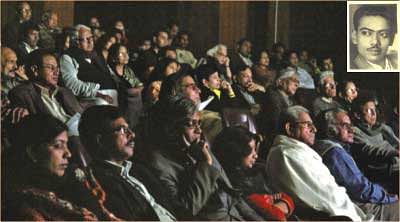Disappearance of an icon

A rapt audience at the screening. Photo: Mumit M.
To commemorate 40 years of Bangladesh's independence, cultural activist and freedom fighter Sentu Roy has made a documentary on Zahir Raihan. Titled “Zahir Raihan”, the documentary premiered at Shawkat Osman Memorial auditorium of Central Public Library on January 29. Bangla Dhoritri organised the screening assisted by Data Soft Systems Limited.
Terming Zahir Raihan a filmmaker, a litterateur and a political activist, Professor Emeritus Anisuzzaman formally launched the screening.
The 80-minute long documentary tries to highlight the entire life of the iconic personality. Interviews of eminent personalities who were Zahir Raihan's peers, friends, family members, colleagues and well-wishers have augmented the authenticity of the work.
“I observed that Zahir had profound love for three things -- love for elders, love for his art, and above all, love for the country,” said Professor Anisuzzaman in the documentary.
A pin-drop silence prevailed in the auditorium when the Tagore song “Boro Bishshoy Lagey” went on, depicting the idyllic beauty of Bangladesh.
Writer Shahriar Kabir said, “Zahir was my cousin. He grew up in a liberated environment. I heard from Comrade Moni Singh that when Zahir was a student of class four/five, he would carry letters of communist leaders.”
Inspired by his elder brother, noted litterateur Shahidullah Kaisar, Zahir Raihan joined the communist party. Zahir Raihan's real name was Abu Abdar Mohammad Zahirullah. His father Mohammad Habibullah was a teacher at Calcutta Madrassa in the then undivided Bengal. Later, he served as a principal at Dhaka Alia Madrassa. Zahir Raihan's mother Syeda Sufia Khatun was a housewife. Third among eight siblings, Zahir was born in Feni on August 19, 1935.
“Zahir was my friend. While studying at Jagannath College in 1949, we along with litterateurs -- Hasan Hafizur Rahman, Shamsur Rahaman and Alauddin Al Azad -- would gather at Pakistan Matth (now Bangladesh Matth) in old Dhaka to discuss how we could take part in the Language Movement. When students were divided on the issue of violating section 144, Zahir Raihan was the first to boldly suggest violating the curfew,” said Dr. Borhanuddin Khan Jahangir.
“Later he was arrested. But during his stay in jail, Zahir Raihan wrote an outstanding novel “Aarek Phalgun” on the Language Movement,” added Dr. Jahangir.
Eminent artist Qaiyyum Chowdhury talked about Zahir's novel “Hajar Bochhor Dhorey” in the documentary. A portrayal of quintessential rural Bengal, “Hajar Bochhor Dhorey”, won an Adamjee Award, according to Qaiyyum Chowdhury.
Zahir Raihan went to Promothesh Barua Memorial Photography Institute, Calcutta (now Kolkata) to study filmmaking. According to filmmaker Amjad Hossen, Raihan's film “Kancher Deyal” received 11 awards at Pakistan Film Festival.
“Zahir Raihan brought about revolutionary changes in Bangla cinema including using cinemascope lens and making films within the shortest possible time. He made a film, 'Rahim Newaz', in only 17 days. His 'Jibon Theke Neya' was a symbolic film, denouncing the autocratic rule of Ayub Khan during the pre-Liberation period,” said actor Hasan Imam.
Veteran actors Anwar Hossain, Razzak, Afzal Chowdhury, writer Abul Hasnat and filmmaker Abu Musa Debu talked about other creative faculties of Zahir Raihan. Panna Kaisar, widow of Shahidullah Kaisar, revisited the memories of her brother in law in the film.
“The birth of Bangladesh stands on two important events. One is Language Movement and the other is Liberation War. Zahir Raihan's two outstanding works -- 'Aarek Phalgun' and 'Stop Genocide' -- superbly showcase these two events,” said Syed Shamsul Haq in the documentary.
Apt use of Gano Sangeet in the documentary articulated the spirit of Language Movement and Liberation War.
On January 30, 1972, Zahir Raihan went looking for his elder brother Shahidullah Kaisar and never returned.
The documentary comes to an end with a mother desperately searching for her missing son among corpses -- those massacred by the Pakistani army and their local cronies.
A post-screening open discussion followed where experts and the audience took part.

 For all latest news, follow The Daily Star's Google News channel.
For all latest news, follow The Daily Star's Google News channel. 



Comments